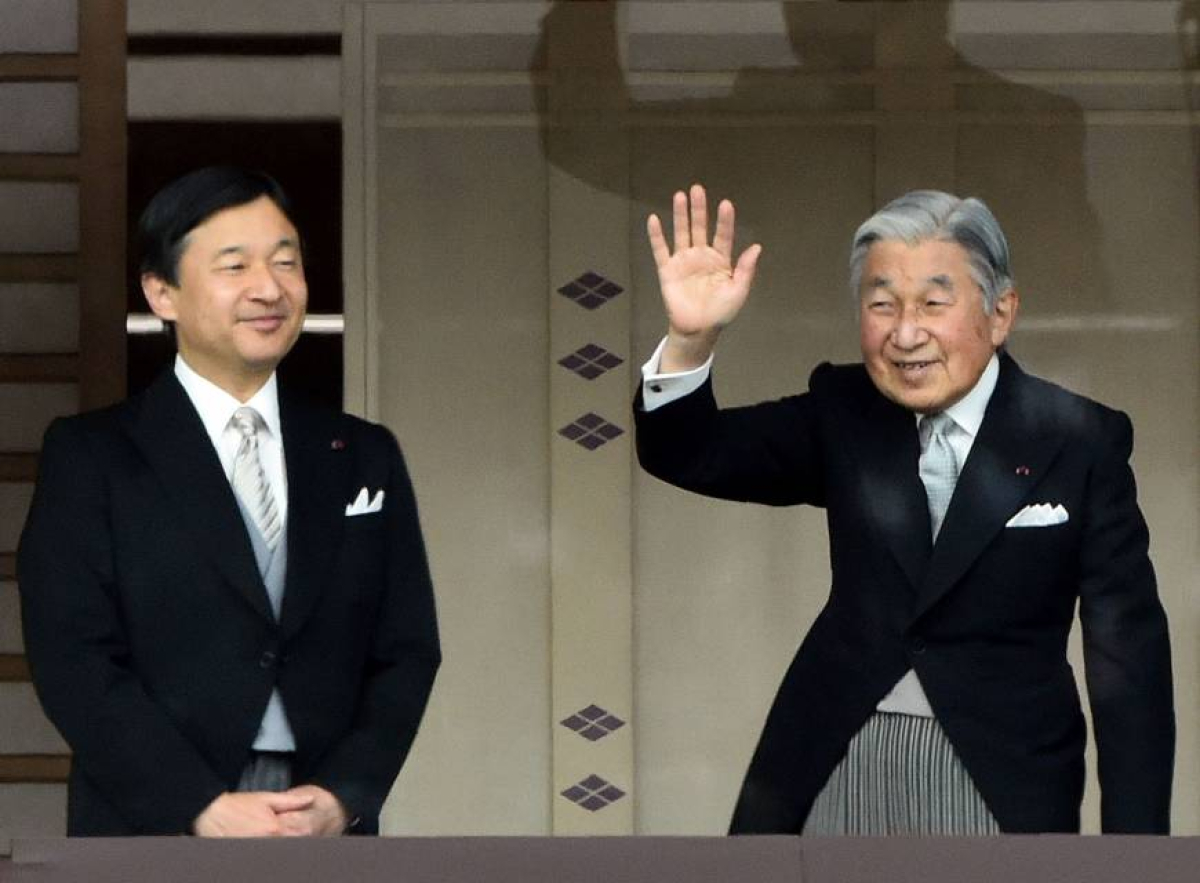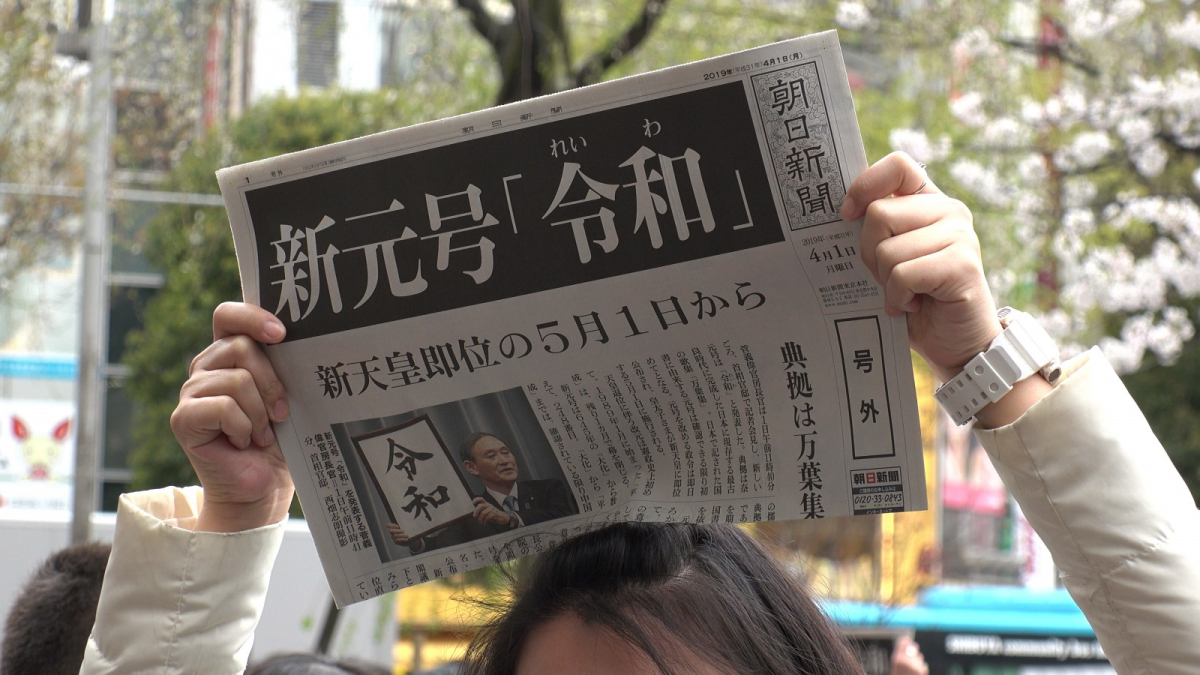On the Enthronement of the New Japanese Emperor and the Question of Religion and Politics in Japan
 Emperor Akihito and Crown Prince Naruhito, 2018
Emperor Akihito and Crown Prince Naruhito, 2018By Elisabeth Marx, Leipzig University
Japan and the Japanese are facing major changes these days: for the first time in 200 years, a new emperor is to be enthroned without his predecessor having died. This unusual procedure has at the same time given rise to far-reaching discussions about the separation of religion and politics in Japan.
The change on the Japanese throne is sweetened for the Japanese by a so-called Super Golden Week – a sequence of successive public holidays adding up to 10-days off of work. One of these holidays, 1 May, was even set by the Japanese Parliament for this year to allow a Super Golden Week from 27 April to 6 May to kick off the new era. Today, on May 1st, the new Emperor Naruhito’s succession celebration will take place. He ascends the Chrysanthemum Throne as the 126th Tennō, following his father Emperor Akihito, who abdicated yesterday, 30th April.
This procedure is highly unusual, as Article 16 of the Imperial Household Law stipulates that the Emperor must remain in office until his death. In the event of a serious illness, however, the Crown Prince can be appointed regent by the Imperial Houshold Council until the death of the Emperor. In August 2016, Emperor Akihito had declared that his poor physical condition no longer allowed him to fulfil his duties.1
After lengthly discussions, the Cabinet had agreed on a unique law, which was passed by the Parliament in May 2017.2 It set the day of abdication after the 30th Anniversary of Emperor Akihito’s accenssion to the throne, for April 30th 2019. Akihito thus yesterday received the title of a retired Emperor: taijō tennō (太上天皇) or jōkō (上皇), a title last awarded 200 years ago in Japan.
What might be expected from the new Era under
Emperor Naruhito?
The inauguration of the new Tenno Naruhito also marks the beginning of a new era (nengō, the form of time calculation that is binding for Japanese authorities). The name of the new nengō “reiwa” (令和)3 was announced by the Prime Minister Abe Shinzō’s Cabinet on April 1st and triggered debates on how the two signs should be interpreted in light of the current political situation in Japan.
The second part of the character compound wa (和), which indicates ‘peace’ or ‘harmony’, was already part of several former nengō – most recently used by Emperor Naruhito’s grandfather Emperor Shōwa in the nengō shōwa (昭和, ‘enlightened/radiant harmony’). It can also be found in the old name of the Japanese empire: Yamato (大和). As part of several compounds, wa (和) designates certain objects or actions as ‘Japanese’ like waka (和歌, which are Japanese poems) or wasai (和裁, refers to kimono tailoring). Therefore, it can be considered as a sign for Japanese cultural heritage and links peaceful/harmonious sentiments to things that are considered Japanese.
The first character rei (令) is more difficult to grasp in its meaning. Often, rei (令) is found in legal or military contexts, indicating orders, commands or laws, but in a traditional honor speech, it also addresses family members of someone who is wealthier or more respected than oneself. Combining both characters can indicate various meanings like ‘commanding peace’ or ‘prestigious Japan’.
The nengō therefore matches perfectly the current debates on the amendment draft by Prime Minister Abe Shinzō and his liberal democratic LDP. The draft represents a rather conservative, traditionalist positions and aims to change the so-called ‘pacifism clause’, article 9 of the current Japanese Constitution. This clause allows to intensivly discuss the meaning of the nengō. Abe himself explained that the nengō
“symbolises our nation’s profound public culture and long tradition. […] Our nation is facing up to a big turning point, but there are lots of Japanese values that shouldn’t fade away. We are very proud of our history, culture and tradition, and this term expresses the Japan of tomorrow, the one we want to build for future generations. That was the most decisive point in making the choice.”4
Many people remain sceptical about the name of the new era, like Mizushima Asaho, a lecturer in constitutional law:
“I can not be pleased with the era name and how it was decided. [… The] Cabinet decides upon everything, even on how to handle the ‘time’ until the revelation. It was just the perfect political show for the Abe administration. […] Rather than in the sense of ‘governance based on the constitution’ (constitutionalism) or ‘politics rooting in law’ (constitutional legality), the image of ‘politics led by commands’ is pretty strong. […] Also, the impression not of ‘peace through law’ but ‘active peace through commands (attended by military power)’ symbolizes perfectly the active pacifism of the Abe school.”5
In view of the fact that the Cabinet decides on the nengō, the question also arises as to how the plans of the new Emperor as “symbol of State and the unity of the People” (Art. 1, COJ)6 can fit.
So far, the former Crown Prince Naruhito has not given a great impression of what can be expected of him. At a press conference in 2017, he answered rather modestly the question of how he imagined the role of the Emperor as a symbol of the state: He wanted to continue the virtues embodied by Emperor Akihito and pray for the peace and happiness of the Japanese people.7 Like his father, Naruhito also opposed historical revisionism in remembrance of the war Japan as well:8
“Although I was born after the war and did not experience it, I think that today, where memories of the war have started to fade, it is important to look back in a humble way on the past and pass on correctly the tragic experiences of war and the knowledge on the course of history, which Japan has followed, from the generation that experienced the war to those who have grown up without first-hand knowledge of it.”9
In February of this year, he declared that the theme of “water” would be a leitmotif in his regency for him, who had already occupied himself much with medieval Japan and the role of “water” as a means of transport and resource in his profession as a historian, in order to serve the unity of the people and preserve Japanese traditions:
“Water, the issues relating to which I have been involved in for approximately ten years, is something that can cause natural disasters through flooding or in other ways, while being also essential for human life. I think that ‘water’ therefore provides a starting point from which I can contemplate ideas about stability, development and prosperity in people’s lives and issues such as disaster risk reduction. Into the future I hope to continue pursuing my interest in ‘water’ issues, as one means of wishing the happiness of the people of Japan and better lives for people in all regions of the world.”10
 A picture of the Asahi Shinbun from 1st April depicting the new era name 'reiwa‘. CUP Magazine Hong Kong, 04.04.2019.
A picture of the Asahi Shinbun from 1st April depicting the new era name 'reiwa‘. CUP Magazine Hong Kong, 04.04.2019.The daijōsai – a religious or a secular Enthronement
ceremony?
In December 2018, the younger brother of new Emperor Naruhito Prince Akishino criticized the government’s plans to finance the enthronement ceremonies – especially the daijōsai – with public funds.11 Since the Imperial family normally refrains from engaging in the political daily events, this criticism was highly unusual and received great attention.
Akishino’s understanding of the ceremony being an Imperial family ritual, and thus unimportant to the nation, echoes in some way the 1990’s debates around the Enthronement ceremonies of former Emperor Akihito. Several cases were filed at that time, which saw the public funding of travel and accommodation for government officials from all over Japan attending the daijōsai as contrary to articles 20 and 89 of the Constitution, which declare the separation of religion and state. An article by Journalist Steven R. Weisman in the New York Times in November 1990 shows how controversial the debates of the time were.12
From both a political and a scientific perspective, there are various competing interpreations of the character and purpose of the daijōsai. It is often seen as an old harvest festival with a long tradition dating back to the 7th century, when was first mentioned as an enthronement ceremony in the chronicle Nihon Shoki. It is often understood to have served the purpose of asking the kami for health for the Japanese people and a rich harvest. Teeuwen and Breed,13 however, argue that it was not primarily a harvest festival, but could have symbolized the gifts of land and sea for the Emperor, as rice is sacrificed from two different rice fields called yuki (悠紀) and suki (主基). Previously, the transfer of heavenly power to the emperor is ritually acconmplished by handing over the Imperial regalia (or ‘Three Sacred Treasures’) from the old to the new Emperor and the new is solemnly enthroned.
Weisman even distinghuishes three interpretations of the daijōsai: as a private rite of the Imperial family; as an Enthronement rite of interest for the public and therefore for the nation in general; and as a religious rite the elevates the Emperor to the status of a deity.14
The conflict over the daijōsai – understood as a Shintō ritual – is strongly influenced by the concept of religion constructed during the Meiji period. Certain parts of Shintō (including the Emperor’s cult) were classified as non-religious at that time in order to give Shintō a superior position vis-à-vis other religions. To this day, these notions of Shintō on the one hand and religion on the other hand stands in contradiction with the understanding of Shintō as a religion by law. Some of the lawsuits in the 1990s were even tried and then dismissed by the Supreme Court because in the Supreme Court’s interpretation the daijōsai, despite its religious roots, was a secular ceremony of national and public importance.
Nevertheless, Prince Akishino called on the government last year to finance the ceremony from the budget of the Imperial family instead of state funds:
“It's a Royal family event, and it is highly religious.[…] The question is if it is appropriate to use government funds to cover the cost of such a highly religious event. […] Personally, I still feel awkward … I still believe [the ritual] should be covered by the Imperial family budget.”15
Akishino even suggested using an existing hall instead of building a new one, as the rite actually requires.16
In view of the fact that new lawsuits have already been filed against the financing of the ceremony from public funds,17 his demands become particularly explosive. However, the government is sticking to its decision, planning to spend around 2.7 billion yen.18 The new Emperor himself only briefly commented on the government’s plans:
“I understand that the government put throughout thoughts into its decisions [regarding the Imperial Enthronement ceremonies and considering the case of the Heisei succession]. I was informed about decisions over several issues again and again. But I’d like to refrain on commenting the content of these decisions.”19
 Temporary hall for the daijōsai inside the Eastern Garden of the Imperial Palace.
Temporary hall for the daijōsai inside the Eastern Garden of the Imperial Palace.References
- http://www.kunaicho.go.jp/page/okotoba/detailEn/12#41
- https://www.bbc.com/news/world-asia-40168983
- https://www.theguardian.com/world/2019/apr/01/reiwa-japan-prepares-to-enter-new-era-brimming-with-hope
- https://www.theguardian.com/world/2019/apr/01/reiwa-japan-prepares-to-enter-new-era-brimming-with-hope
- http://www.asaho.com/jpn/bkno/2019/0401.html
- https://japan.kantei.go.jp/constitution_and_government_of_japan/constitution_e.html
- http://www.kunaicho.go.jp/page/kaiken/showEn/9
- https://edition.cnn.com/2015/02/26/opinion/japan-crown-prince-ww2-comments/index.html
- http://www.kunaicho.go.jp/e-okotoba/02/press/kaiken-h27az.html
- Press Conference by His Imperial Highness The Crown Prince on the Occasion of His Birthday, 2017)
- https://www3.nhk.or.jp/nhkworld/nhknewsline/backstories/princeakishino/
- https://www.nytimes.com/1990/11/23/world/akihito-performs-his-solitary-rite.html
- Breen, John; Teeuwen, Mark (2010): A new history of Shinto. Chichester, West Sussex, Malden, MA: Wiley-Blackwell
- https://www.nytimes.com/1990/11/23/world/akihito-performs-his-solitary-rite.html
- https://www.abc.net.au/news/2018-12-01/japanese-prince-wants-royals-to-pay-for-succession-ceremony/10573894
- https://www.japantimes.co.jp/news/2018/12/25/national/prince-akishino-proposed-cutting-costs-key-shinto-linked-imperial-succession-rite-2016/#.XLeXOaTgqCg
- https://www.japantimes.co.jp/opinion/2018/12/16/editorials/questions-daijosai-rite-arise/#.XLeXSaTgqCh
- https://www.japantimes.co.jp/news/2018/12/21/national/costs-key-daijosai-imperial-ceremony-total-%C2%A52-7-billion/#.XL72l6TgqCg
- http://www.kunaicho.go.jp/page/kaiken/show/26


